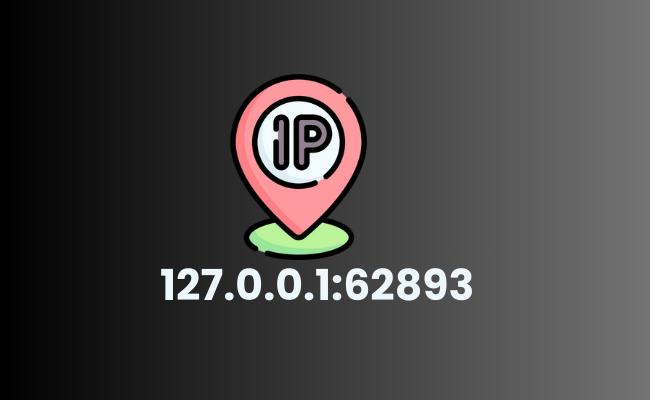
What is 127.0.0.1?
127.0.0.1 is the loopback IP address, commonly referred to as localhost. When you ping 127.0.0.1, essentially that means you are pinging your own machine. It helps to establish a network connection to the same device you’re using and is important for testing and development.
Understanding the Port Number 62893
The port number 62893 is an arbitrary number chosen by an application for communication.
Port numbers range from 0 to 65535, and those above 49152 are dynamic or private, and are not reserved for any specific service and can help any application that requests them.
Key Features of Port 62893
- Firewall and Router Logs: The port is used to check firewall or router logs and will provide insights into which devices and services are communicating over this port.
- Network Monitoring: Network monitoring tools like Wireshark or tcpdump use it to capture traffic and identify the protocols or applications.
- Service Detection: Tools like Nmap can perform service detection on port 62893. The command
nmap -sV -p 62893 <target>can attempt to identify the service running on that port.
How Does 127.0.0.1:62893 Work?
When an application on your local machine wants to communicate with another application running on the same machine, it can use the loopback IP address 127.0.0.1. The port number 62893 serves as a specific endpoint for this communication. Here’s how it works:
The application that needs to listen for incoming connections binds to 127.0.0.1:62893 and tells the operating system to route any traffic sent to this IP address and port to the application.
Another application (the client) on the same machine can then connect to this address and port to communicate with the server application. Once the connection is established, data can be sent back and forth between the server and client applications.
Benefits of Using 127.0.0.1:62893
1. Development and Testing
Running applications locally on 127.0.0.1:62893 allows developers to test features and functionalities without affecting the live environment and helps to ensure that the code works fine before deploying.
2. Security
Since 127.0.0.1 is not exposed to the external network, it reduces the risk of external attacks. Only processes running on the same machine can access services on localhost, and thus the development environment is isolated from potential threats.
3. Performance and Efficiency
Local communication is generally faster than network communication, as it bypasses many layers and potential threats in network transmission. 127.0.0.1:62893 will ensure that data transmission is efficient, during the debugging.
4. Isolation and Stability
127.0.0.1:62893 isolates the testing environment from the live environment and helps prevent accidental data corruption or service interruptions in the production environment.
5. Troubleshooting and Debugging
Using 127.0.0.1:62893, developers can easily diagnose issues in a controlled environment. Local logs, breakpoints, and other debugging tools can work without remote access.
Is It Safe To Expose Port 62893 Publicly?
Exposing any port publicly can be a security risk, and port 62893 is no exception. By default, localhost (127.0.0.1) is not exposed to the public network, and is only accessible from the local machine.
However, if you configure your network settings to expose this port publicly, you open your system to potential attacks.
Port 62893, like any other port, can be assigned to a particular service or application. While port numbers in the range of 49152–65535 are considered dynamic and can be used by any application that needs them.
Security Risks of Exposing Port 62893

Exposing any port to the public internet can have different security risks:
1. Unauthorized Access
When you expose a port publicly, you risk unauthorized users to access the service and hackers often scan for open ports to exploit vulnerabilities.
2. Data Interception
Without proper encryption, data transmitted through the exposed port can be intercepted and can lead to data breaches.
3. Denial of Service (DoS) Attacks
Publicly exposed ports can become targets for DoS attacks, where unauthorized users flood the port with traffic and cause disruptions.
4. Exploitation of Vulnerabilities
If the application or service running on port 62893 has any security vulnerabilities, exposing the port can make it easier for attackers to exploit these weaknesses.
FAQs
1. Why is 127.0.0.1 called localhost?
127.0.0.1 is known as localhost because it is the standard IP address used to refer to the local computer and enables communication within the same machine.
2. Can I use any port number with 127.0.0.1?
Yes, you can use any port number within the valid range (0-65535). However, it’s best to use ports above 49152 for dynamic or private services to avoid conflicts with well-known ports.
3. Is it safe to use 127.0.0.1:62893 for live applications?
While 127.0.0.1:62893 is great for development and testing, it’s not intended for live applications that need to be accessed over a network. For live environments, proper network configurations and security measures should be in place.
4. How can I ensure my application is secure when using localhost?
Ensure that your application is only accessible via localhost and not exposed to the external network. Use firewalls and access controls to restrict access.
5. Can multiple applications use 127.0.0.1:62893 simultaneously?
No, only one application can bind to a specific port at a time. If multiple applications need to run simultaneously, they must use different ports.
Conclusion:
127.0.0.1:62893 might seem like a string of random numbers, but understanding it can make a difference in your development and debugging processes.
It’s powerful for local development, provides a secure way to test applications.
Also Read:
